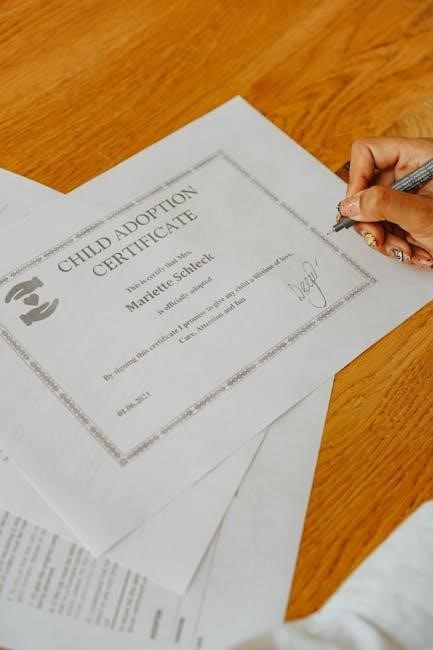Self-certification forms are documents used to confirm compliance with regulations or standards without external verification. They streamline processes, ensuring efficiency and accuracy in various applications.
What is a Self-Certification Form?
A self-certification form is a document used to declare compliance with specific standards, regulations, or requirements. It allows individuals or organizations to affirm the accuracy of information without external verification. Commonly used in employment, legal processes, and business compliance, these forms streamline administrative tasks and reduce the need for third-party validation. They often include fields for personal details, such as name, job title, and reason for certification, ensuring a straightforward and efficient process. Self-certification forms are widely accepted as a reliable method for verifying information in various professional and legal contexts.
Importance of Self-Certification Forms
Importance of Self-Certification Forms
Self-certification forms are crucial for streamlining processes, reducing costs, and empowering individuals. They enhance efficiency by eliminating the need for external verification, allowing quick actions like sick leave approvals. Cost-effective, they save organizations money by avoiding external auditors. These forms promote personal accountability, encouraging accuracy since individuals have firsthand knowledge. Simplifying administration, they bypass complex procedures, making compliance easier. Legally, they provide a safeguard, deterring false information. Accessible online, they facilitate easy downloads for anyone. However, they require careful design and implementation, possibly with audits, to ensure reliability and effectiveness.

Uses and Applications of Self-Certification Forms
Self-certification forms are widely used for employment verification, legal processes, and business compliance; They simplify administrative tasks and ensure adherence to regulations efficiently across various industries.
Employment and Sick Leave
Self-certification forms are essential for verifying employee absences due to sickness. They allow employees to confirm their absence without requiring a doctor’s note for up to seven days. This streamlined process ensures compliance with company policies and statutory requirements, making it easier for employers to manage payroll and HR records. The form typically includes details like absence duration, reason, and employee information, ensuring transparency and efficiency. It also provides a straightforward way for employees to self-certify their leave, reducing administrative burdens and supporting smooth workflow. This method is widely adopted across industries to maintain accurate and reliable attendance records.
Legal and Administrative Processes
Self-certification forms play a crucial role in legal and administrative processes by providing a formal declaration of compliance with specific regulations. They are often used in licensing, permitting, and other official procedures where individuals or organizations must attest to meeting certain standards. These forms help reduce the need for extensive documentation and third-party verification, streamlining administrative tasks. In legal contexts, they serve as valid evidence of adherence to rules and requirements, ensuring accountability and transparency. By utilizing self-certification, entities can efficiently demonstrate compliance, facilitating smoother operations and maintaining legal integrity. This approach is widely recognized for its effectiveness in managing regulatory obligations.
Business Compliance and Verification
Business

Downloading a Self-Certification Form in PDF Format
Self-certification forms in PDF format can be easily downloaded from trusted websites or official portals. Ensure compatibility with Adobe Reader for seamless access and printing.

Where to Find Reliable Templates
Reliable self-certification form templates can be sourced from official government websites, legal document platforms, or company intranets. Websites like HMRC or legal services providers often offer standardized templates for download. Additionally, platforms specializing in business or HR documents provide customizable forms. Ensure templates are compliant with local regulations and tailored to specific needs, such as sick leave or compliance certifications. Always verify the source’s credibility to avoid outdated or incorrect forms. Using trusted portals guarantees accuracy and saves time in drafting from scratch.
Steps to Download and Save the Form
To download and save a self-certification form, start by accessing a reliable source, such as an official government website, legal document platform, or your employer’s portal. Locate the form by searching for keywords like “self-certification form PDF.” Once found, click the download button or link provided. Ensure the file is in PDF format for compatibility. After downloading, save it to a designated folder on your device for easy access. If necessary, rename the file for clarity. Double-check that the form is up-to-date and applicable to your needs before proceeding. This ensures you have a valid and usable document ready for completion.
Filling Out the Self-Certification Form
When completing a self-certification form, ensure all fields are filled accurately. Provide personal details, reason for certification, and any additional required information. Review for completeness.
Required Information and Fields
Self-certification forms typically require specific details to ensure compliance and accuracy. Common fields include the individual’s full name, unique identifier, department, job title, and the reason for certification. Additional sections may request dates, absence duration, or specific declarations. The form often includes a statement confirming the truthfulness of the provided information. Depending on the context, fields may vary, such as health-related details for sick leave or compliance statements for regulatory purposes. Ensure all mandatory fields are completed accurately to avoid delays or rejection. Properly formatted PDF templates often highlight required sections, making it easier to identify and fill them out correctly. Always review the form before submission.
Guidelines for Accurate Completion
To ensure your self-certification form is completed accurately, carefully read all instructions before filling it out. Use clear, legible handwriting or typed text if possible. Highlight or bold required fields to avoid missing any essential information. Check boxes or select options that apply to your situation, and provide detailed explanations where necessary. Ensure dates, names, and identifiers are correct to prevent errors. Review the form for completeness before signing and dating it. If using a PDF, ensure it is compatible with Adobe Reader for proper functionality. Double-check for any specific instructions or attachments required, such as additional documentation or declarations. Proofread your entries to avoid mistakes.

Submitting the Completed Form
Submit the completed form to your employer or relevant authority within the specified deadlines. Ensure all information is accurate and retain a copy for your records. Electronic submissions may be accepted.
Submission Methods and Deadlines
Completed self-certification forms can be submitted via email, online portals, or in-person, depending on the organization’s requirements. Deadlines vary, but forms are often due within a week of absence or event. Ensure timely submission to avoid delays in processing or compliance issues. Digital submissions are preferred for efficiency, while printed forms may require signatures. Verify submission methods and deadlines with the relevant authority to meet obligations effectively; Late submissions may result in penalties or additional documentation requests. Always retain a copy for personal records and follow up if confirmation is needed.
Verification and Approval Processes
After submitting a self-certification form, it undergoes verification to ensure accuracy and compliance. Employers or administrators typically review the details, checking for completeness and authenticity. Automated systems may also validate the information, especially for digital submissions. Once verified, the form is approved, and the individual receives confirmation, often via email or through an online portal. If discrepancies are found, the form may be rejected, requiring resubmission. It’s essential to ensure all details are correct to avoid delays. Approved forms are then processed for the intended purpose, such as granting sick leave or completing administrative tasks. Always retain a copy for personal records.
Self-certification forms offer a convenient and efficient way to verify information, reducing administrative burdens. Downloading these forms in PDF format ensures accessibility and ease of use. By following the guidelines and accurately completing the form, individuals can streamline processes in employment, legal matters, and compliance. Always ensure the form is submitted on time and verified by the relevant authority. Utilizing reliable templates and understanding the requirements can save time and effort. Self-certification forms are a valuable tool for maintaining compliance and facilitating smooth operations in various sectors. Ensure to explore available templates and resources to make the most of this efficient documentation method.

Leave a Reply
You must be logged in to post a comment.